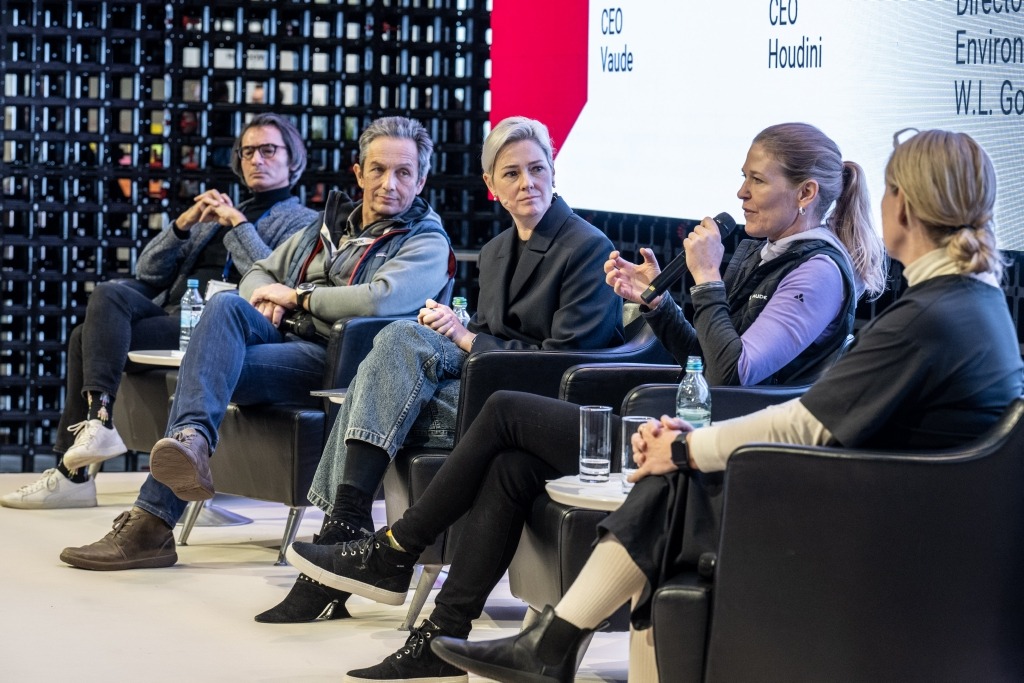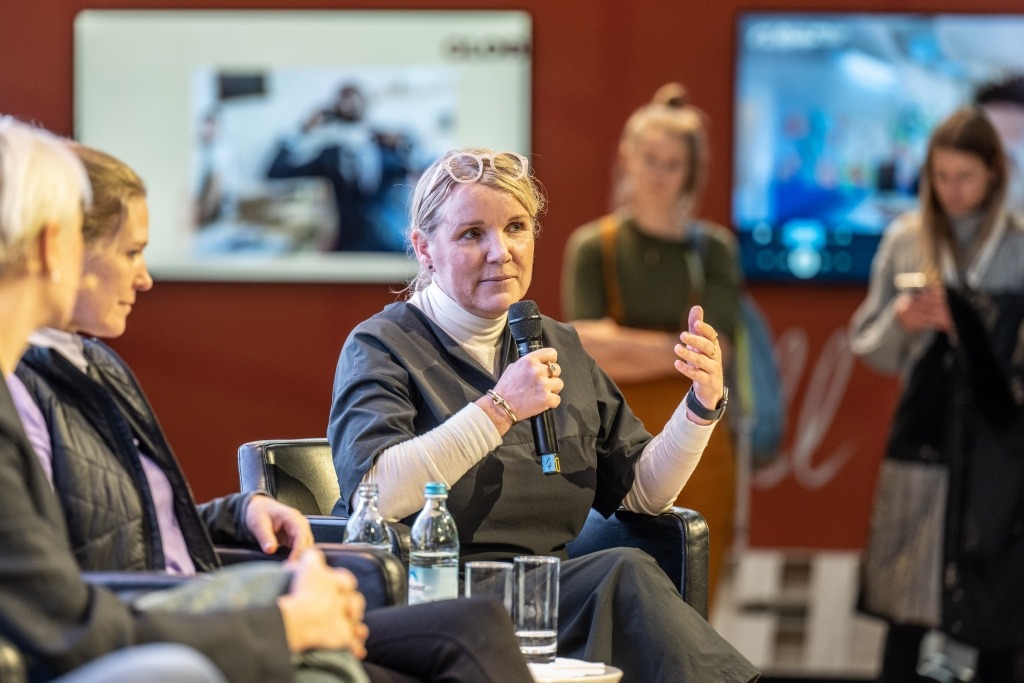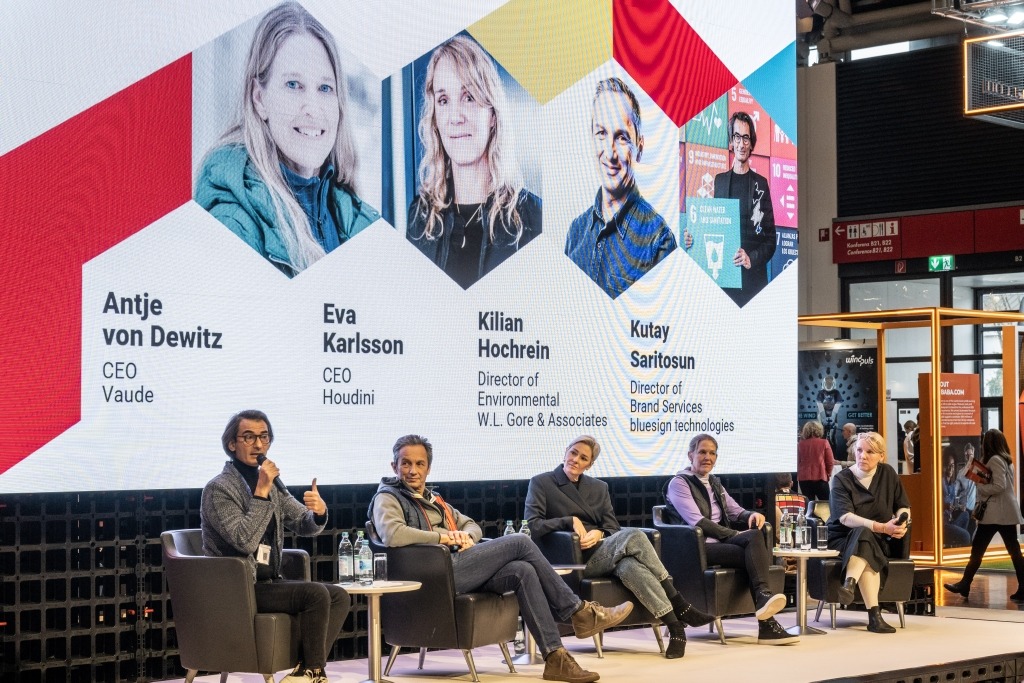

At the world’s largest trade show for the outdoor and sports industries, brands, manufacturers, materials innovators and chemical companies gathered to discuss and conduct business. Business, and the manner in which it is conducted, needs to change, based on my assessment of the past 20 years of sustainability efforts sector-wide – spanning clothing and textiles. This is not a matter of my opinion but of research-based evidence, outlined in detail in the book I recently authored: Made with Bluesign – Enabling a better future.
And that detail was the topic of a panel discussion I moderated at ISPO1 yesterday, attended by an audience of the stakeholders mentioned above, to dig deeper into the book’s findings. I first presented a snapshot of how the industry evolved, charting global population growth, the establishment of today’s mega brands and significant chemical industry discoveries, including polyester, nylon and perfluorochemicals, including the PFAS ‘forever chemicals’. These events were placed on a timeline which also included industrialised mass production followed by manufacturing outsourcing, effectively inking the divorce between brands and the making of their products (bar the transaction to purchase their branded ready-made goods from the outsourced suppliers).
Also plotted along this timeline of industry turning points were all seven IPCC reports, the advent of Gross Domestic Product (GDP) economics and the launch of the first environmental impact assessment frameworks by Bluesign (2000), The Eco Index (2011) and the Sustainable Apparel Coalition’s Higg Index (2012). This multi-event timeline could, crudely, be summarised as follows: a hundred years of industrialised mass production and chemical abandon were followed by 20 years of scrambling to devise, agree and implement impact assessment methods (note that impact mitigation remains largely a future plan).
Sustainability, then, is relatively new. It’s just 20 years old, while Levis, for example, is 120. H&M is 75 years old; Adidas 71. Even Zara, a relative newcomer, is approaching its 50th birthday. So today’s mega brands have operated independently of, for most of their existence, the environmental and social impact assessment and actions required in this age of devastating climate risk. What were previously ‘externalities’ are now material financial risks, as supply chains are hit with extreme weather events causing vulnerability of raw material supplies and surging energy prices.

During the panel discussion, Eva Karlsson, CEO of Houdini Sportswear2, founded in 1993 in Sweden, declared an entirely different remit for the CEOs of today. She explained that drawing lines around a company’s impact that do not include nature are nonsensical. Upon joining the company as CEO in 2001 and assessing its materials and products, her first step was to reject the idea of scaling the company as it was – of ‘”scaling harm”, as Karlsson put it in the book. Instead, she set about applying common sense, encompassing the wisdom of nature: that all things return to Earth and that nature’s inbuilt circularity and absence of waste is the only model by which to operate. She rejects the “technocratic” approach to assessing company health and wealth by financial metrics alone. This extends as far as composting the company’s garments to nourish the growth of food that has found its way into a fine-dining menu in Stockholm. Hers is a declaration of kinship with the planet and people, rather than a fight to extract as many resources as possible until depletion spells total disaster.
Antje von Dewitz admitted that she shares the vision and philosophy of Karlsson and explained that the sustainability journey of her company, Vaude3, began in 2008. In fact, converting their manufacturing facility in Germany to renewables way back then has provided insulation from today’s surging energy prices. Despite operating with 100 staff at their HQ in Germany, which manufactures select products for the brand, their costs have remained relatively stable, she said in a pre-panel interview. In practice, being ahead of the sustainability curve has meant sensible resource efficiency since more than a decade ago. Therefore, this investment in renewable energy was not a marketable sustainability ploy but a common-sense transition that is now paying financial and environmental dividends.
Such a distinction between practical ‘resource efficiency’ and buzzy ‘sustainability’ language was further underlined by Kutay Saritosun, Director of Brand Services at Bluesign technologies. The company has been mapping resource use to create action plans for efficiency since 2000 – not for a ‘sustainability’ competitive edge, but because it reduces costs through reduced energy and water usage (again falling into the common sense decision-making bracket mentioned previously).
On the resource use side, it’s worth highlighting Vaude’s milestone, quantifying the emissions of their products manufactured by their suppliers, primarily located in Asia. According to von Dewitz, the two-year project identified that over 90% of Vaude’s total emissions impact is in Scope 3. Of this, 60% is due to using coal energy to power textile and manufacturing processes, and 30% was attributable to the materials themselves. This insight is proving transformational in that it enabled the accurate setting of Vaude’s SBTs and preceded their joining the European Outdoor Group (EOG) multi-brand initiative to reduce emissions sector-wide.
The EOG initiative brings together multiple brands, pre-competitively, to determine the suppliers they share and collaboratively channel resources into their transition to renewable energy. After all, the brands are all setting SBTs and all stand to benefit from shared investment in renewable energy infrastructure. In parallel, Vaude is switching to preferred and recycled options to minimise material impacts, which they have “achieved for 72% so far,” the CEO revealed.

Underpinning all of this impact assessment and decision-making is an understanding of the role of chemistry in the material preparation, dyeing and finishing processes of textiles. According to global databases like Quantis WALDB and data gathered by Bluesign and others, this is well established as the primary contributor to emissions and a significant drain on water sources. Kilian Hochrein, Director of Environmental Affairs at W.L. Gore & Associates4 and a 40-year chemical industry veteran, took no shortcuts in explaining how complex and nuanced such an impact assessment is.
During the discussion, he took a swipe at the bureaucratic approach of sustainability professionals today, which he says focuses on paper shuffling and checkboxes instead of R&D and implementing impact-reducing solutions. He pleaded to those in sustainability roles to stop using sustainability metrics as a competitive edge – especially where such an edge provides no discernable environmental or social benefit. He requested that they instead focus on the established impact baselines and interrogate the opportunities outside of bureaucracy to reduce impact, pointing to Houdini and Vaude as examples of this higher ambition.
Hochrein also provided helpful context to question the sustainability assumptions placed on materials rather than on the processes they undergo. He explained that a materialistic definition of sustainability is flawed thinking before asking the 100-strong audience to consider how sustainable wood is when burned in a furnace versus bolted into timber building structures where its carbon remains trapped for hundreds of years. It is not the material that is sustainable, but how it is used and for what duration. The colour he added to the discussion was substantiated by the words of Saritosun, who shared Bluesign’s remit with manufacturers to capture impact data and create a roadmap to reduce emissions, water usage and chemical load. The manufacturers can then provide this data to brands, he explained.
In addition to textile and product manufacturers, Bluesign5 has over 200 chemical companies as partners and tracks the impacts of making their formulations and the subsequent impacts when used by manufacturers. There is a data ‘black spot’, though, and it is the impact of extracting fossil fuels (the feedstock for most synthetic chemicals) and the initial petrochemical processing before the chemical formulations are made. “This is data we don’t have,” Saritosun conceded off-stage during a briefing before the panel discussion. It is a data gap I’ve highlighted before about synthetic textile production and one I am gathering intel on for a second instalment in my methane emissions analysis (see part 1 here).
Adding further to the discussion of sustainability priorities today, Hochrein believes that many companies focus on sustainability checklists as a licence to continue operating as they already do. Instead, he says, such checks need to become a licence to do business full stop. After 27 years of working in this area at Gore, he is adamant that dangerous levels of distraction by brand-specific sustainability requirements that don’t result in material impact reductions are halting the progress the industry so urgently needs. He believes common sense would help turn the tide on these piles of paperwork.
Eva Karlsson closed the discussion with a warning that impact assessment is not the whole picture, urging the audience to recognise that the Higg Index, for example, will never quantify the impact that today’s businesses are having on the planet and people. It is only part of the picture. And to complete it, according to the revealingly straightforward accounts of all the panellists, might only require common sense.
To read the full insights from the book, including in-depth interviews with Karlsson, von Dewitz and Hochrein, alongside 20 other experts, click here.

